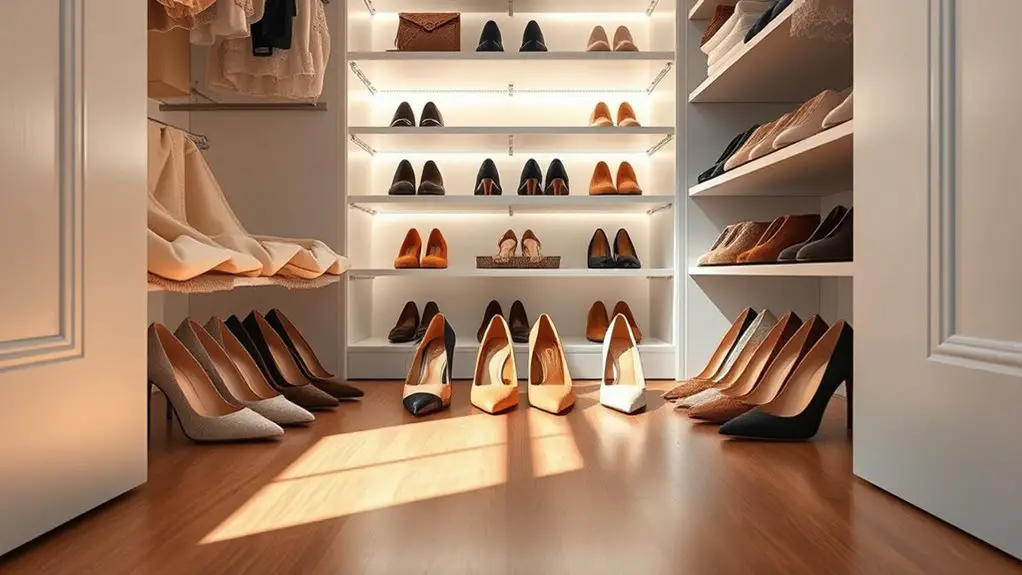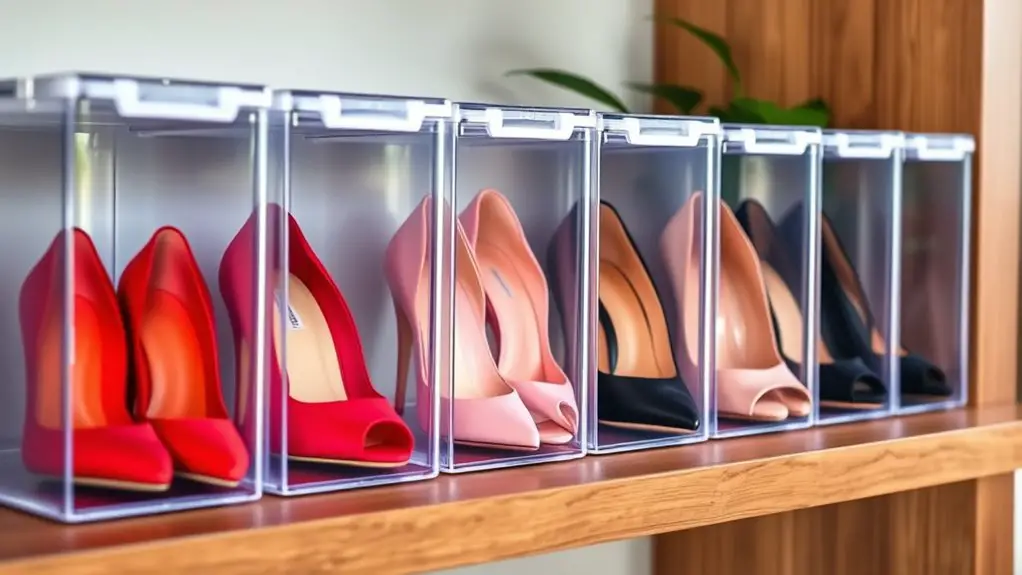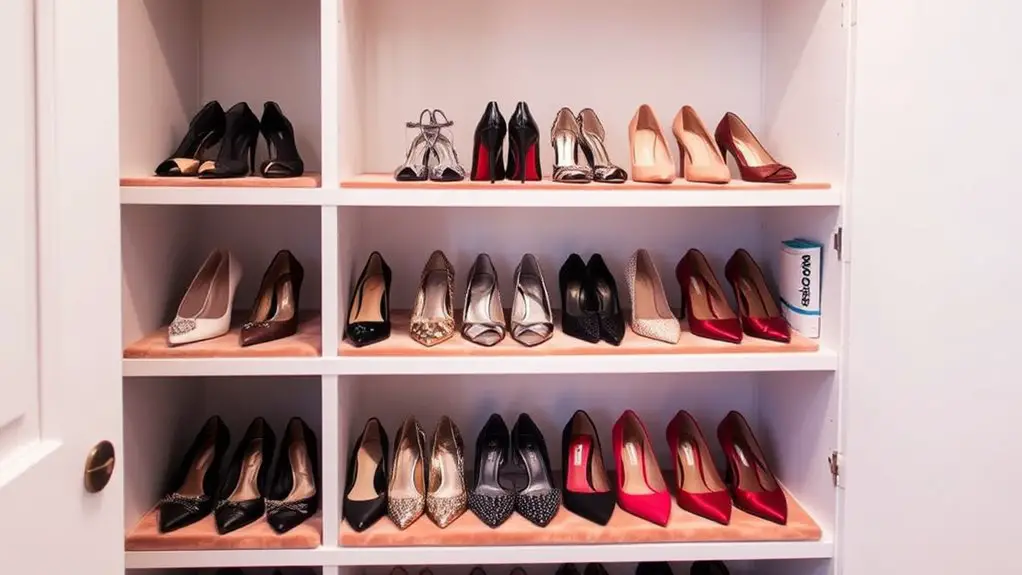To store your heels while preventing dust and mold, start by choosing the right storage environment with humidity levels between 40-60% and temperatures from 60-75°F. Utilize shoe boxes for protection and consider clear storage bins for visibility. Keep your heels off the ground and use shoe trees to maintain their shape. Avoid direct sunlight and regularly clean and inspect your heels. You might also want to explore using silica gel packs for added moisture control.
Choose the Right Storage Environment

When you’re looking to store your heels properly, it’s vital to take into account the environment in which you keep them. A stable environment is fundamental for maintaining their quality. Start by focusing on humidity control; excess moisture can lead to mold growth and damage the materials. Ideally, aim for a humidity level between 40-60%.
Next, consider temperature regulation. Heels should be stored in a cool, dry place, away from direct sunlight, which can fade colors and weaken materials. A temperature range of 60-75°F is perfect for preserving your shoes.
Investing in a dehumidifier or using moisture-absorbing packets can help maintain the right humidity levels. If you live in a particularly humid area, make certain your storage space is well-ventilated. By controlling these environmental factors, you’ll keep your heels looking fabulous for years to come.
Utilize Shoe Boxes for Protection
Maintaining the right environment for your heels is just the beginning of effective storage. Utilizing shoe boxes is a fantastic way to protect your prized footwear. One of the shoe box benefits is that they shield your heels from dust and potential mold growth, keeping them in pristine condition. When you place your heels in their original boxes, you also maintain their shape, preventing creasing and scuffs.
Moreover, using shoe boxes promotes organized storage. You can easily stack them or label each box, making it simple to locate specific pairs without rummaging through clutter. Consider adding silica gel packets inside the boxes to absorb moisture, further deterring mold. By incorporating shoe boxes into your storage routine, you not only safeguard your heels but also create a tidy, efficient space that enhances your overall shoe collection management.
Invest in Clear Storage Bins

Investing in clear storage bins can revolutionize the way you store your heels. These clear containers not only protect your shoes from dust and potential damage, but they also allow you to see your collection at a glance. When you use clear bins, you can easily identify your favorite pairs without rummaging through opaque boxes.
To maximize space and keep your heels in pristine condition, arrange these bins on organized shelves. This method helps you maintain order while showcasing your collection. You’ll appreciate how accessible your heels become, making it simple to choose the perfect pair for any occasion.
Additionally, clear storage bins can be stacked, which saves valuable floor space and keeps your area tidy. By investing in this storage solution, you’ll not only preserve your shoes but also create a stylish display that enhances your room’s aesthetic.
Keep Heels Off the Ground
Keeping your heels off the ground is crucial for maintaining their shape and longevity. When shoes sit on the floor, they’re more susceptible to dust, dirt, and moisture, which can lead to mold growth. To properly elevate your heels, consider these options:
- Wall Rack: Install a wall rack at an appropriate shelf height to display your heels. This keeps them visible and off the ground, reducing dust accumulation.
- Shoe Shelves: Opt for shoe shelves with enough space between each level. Guarantee the shelf height accommodates your tallest heels, preventing them from being squished or misshapen.
- Under-Bed Storage: If space is tight, use under-bed storage bins. This elevates your heels, keeping them protected while maximizing your storage area.
Use Shoe Trees for Shape Maintenance

While it might seem like a small detail, using shoe trees can greatly extend the life of your heels by preserving their shape. Shoe trees are designed to fit snugly inside your footwear, maintaining the delicate contours and structure of your heels. This is especially important for materials like leather, which can easily lose their form over time.
One of the primary shoe tree benefits is their ability to absorb moisture, preventing the growth of mold and mildew. When you store your heels with shoe trees, you’re not only keeping them in shape but also promoting a healthier storage environment. Additionally, shoe trees can help minimize creasing and cracking, guaranteeing that your heels look as good as new for longer.
Incorporating shoe trees into your storage routine is a simple yet effective way to make certain your heels remain pristine and ready to wear whenever you need them.
Avoid Direct Sunlight
To keep your heels in top condition, it’s essential to avoid direct sunlight. Store them in dark areas where they won’t be exposed to harmful UV rays, which can fade colors and weaken materials. Using protective covers and rotating their storage position can also help maintain their quality over time.
Choose Dark Storage Areas
When you’re storing your heels, choosing a dark area can greatly extend their lifespan, as exposure to direct sunlight can cause fading and damage to materials. A dark closet not only protects your shoes from harmful UV rays but also helps maintain temperature control, preventing warping and deterioration.
Here are three tips for effective dark storage:
- Use a dedicated shoe cabinet: This keeps your heels organized and shielded from light.
- Choose breathable fabric boxes: These allow air circulation while keeping dust at bay.
- Avoid damp areas: Make sure your dark storage space isn’t prone to humidity, as excessive moisture can lead to mold.
Use Protective Covers
Even if you’ve found the perfect dark storage area for your heels, it’s still essential to use protective covers to shield them from any potential light exposure. Sunlight can fade colors and damage materials over time, so choosing the right cover types is vital. Opt for protective materials like soft cotton or microfiber that won’t scratch your shoes. Consider breathable shoe bags or boxes that allow air circulation while blocking out light. Avoid plastic covers that can trap moisture, leading to mold growth. By using protective covers, you not only preserve the integrity of your heels but also maintain their aesthetic appeal. It’s a simple yet effective step in ensuring your beloved shoes stay in top condition for years to come.
Rotate Storage Position
Although you might have a designated spot for your heels, rotating their storage position can greatly reduce the risk of damage caused by direct sunlight. By changing the orientation of your heels periodically, you can prevent uneven fading and degradation.
Consider these rotation techniques:
- Horizontal Rotation: Store your heels flat in pairs, adjusting their position every few weeks to guarantee even exposure to light.
- Vertical Rotation: If you prefer displaying them upright, alternate which pair faces forward to minimize sun impact on any single pair.
- Seasonal Storage: Rotate your collection seasonally, placing less-used pairs in darker areas to shield them from sunlight.
Implementing these strategies will help maintain the integrity of your beloved heels.
Regularly Clean and Inspect Your Heels
Regularly cleaning and inspecting your heels is essential for maintaining their appearance and longevity. Start by establishing a cleaning routine that suits your shoe materials. For leather, use a soft cloth and a specialized cleaner, while suede requires a brush and suede-safe cleaner. Don’t forget to clean the soles as well; dirt can accumulate and affect their integrity.
As part of your inspection routine, check for signs of wear, such as scuffs, loose stitching, or damaged heels. Addressing these issues early can save your heels from more extensive damage. Look for any discoloration which might indicate mold or mildew, especially if they’ve been stored for a while.
Finally, keep a record of your cleaning techniques and inspection findings. This will help you track any recurring issues and guarantee you’re taking the best care of your beloved heels. Regular maintenance not only keeps them looking great but also extends their lifespan.
Consider Using Silica Gel Packs
Have you ever wondered how to keep your heels in pristine condition while they’re stored away? One effective method is using silica gel packs for moisture control. These little packets absorb excess humidity, protecting your beloved shoes from mold and mildew. Here’s how to make the most of them:
Keep your heels safe from mold and mildew by using silica gel packs for effective moisture control.
- Place Silica Gel Packs Inside: Slip a couple of silica gel packs into each shoe to prevent moisture buildup.
- Seal in a Container: Store your heels in a sealed container or dust bag. This further enhances their protection against dust and moisture.
- Regularly Replace Packs: Check the silica gel packs periodically and replace them when they become saturated to maintain effective moisture control.
Frequently Asked Questions
How Often Should I Clean My Heels Before Storing Them?
You should clean your heels after each wear, but at least monthly is ideal. This cleaning frequency guarantees they stay in good condition. Combine this with proper storage tips to maintain their beauty and longevity.
Can I Store Heels in the Closet With Other Shoes?
Imagine you’re organizing a closet with limited space. You can store heels with other shoes, but make certain you use shoe organizers to maximize closet space and keep them protected from scuffing and dust accumulation.
Is It Safe to Store Heels in the Attic?
Storing heels in the attic isn’t ideal due to fluctuating attic temperatures and humidity control issues. These conditions can damage your shoes, causing materials to warp and degrade, so consider a more stable environment for storage.
What Materials Are Best for DIY Shoe Storage?
When crafting DIY shoe storage, consider elegant wooden boxes for structure and breathable bags to maintain freshness. These materials not only protect your shoes but also add a charming touch to your home decor.
How Do I Prevent Pests in My Shoe Storage Area?
To prevent pests in your shoe storage area, maintain good shoe organization and implement pest control measures, like using airtight containers, regularly cleaning the space, and employing natural repellents to deter insects and rodents effectively.



